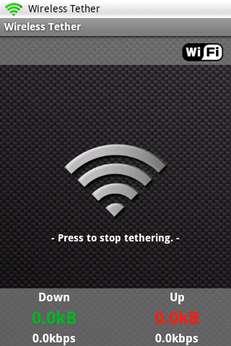Turn Your (Rooted) Android Device into a WiFi Hotspot with Wireless Tether

Productivity Sauce
There are two ways to turn your Android phone into a mobile wireless hotspot: you can either buy a device running Android 2.2 Froyo, or you can root your current Android phone and install the Wireless Tether application. I did the latter, and rooted my HTC Magic using the Amon Ra's Clear Donut ROM which includes Wireless Tether. True, rooting an Android device is not particularly straightforward, and there is a risk of bricking the device in the process, but it's really worth it. Having a mobile wireless hotspot in your pocket can come in handy in many situations, especially when you travel abroad. In some countries like Germany, you can buy a daily pass which offers unlimited data connection for a reasonable price. This means that you don't have to pay through the nose for wonky hotel WiFi, and you can access the Internet on the go.
Despite its apparent simplicity, Wireless Tether is a rather competent tool. It allows you to specify the desired SSID name, turn SSID broadcasting on and off, enable encryption (albeit it supports only 128-bit WEP), and select the channel you want. Better yet, you can enable the access control feature, so you can prevent unwanted connections. Using Wireless Tether is ridiculously easy. Launch the app, and press the big Tether button. A handy status bar at the bottom displays the amount of downloaded and uploaded data. And that pretty much covers Wireless Tether's features.
There are, of course, other ways to tether Android devices, but they are all limited in one way or another. So if you are not afraid of rooting your phone, then you ought to give Wireless Tether a try.
Comments
comments powered by DisqusSubscribe to our Linux Newsletters
Find Linux and Open Source Jobs
Subscribe to our ADMIN Newsletters
Support Our Work
Linux Magazine content is made possible with support from readers like you. Please consider contributing when you’ve found an article to be beneficial.

News
-
Two New Distros Adopt Enlightenment
MX Moksha and AV Linux 25 join ranks with Bodhi Linux and embrace the Enlightenment desktop.
-
Solus Linux 4.8 Removes Python 2
Solus Linux 4.8 has been released with the latest Linux kernel, updated desktops, and a key removal.
-
Zorin OS 18 Hits over a Million Downloads
If you doubt Linux isn't gaining popularity, you only have to look at Zorin OS's download numbers.
-
TUXEDO Computers Scraps Snapdragon X1E-Based Laptop
Due to issues with a Snapdragon CPU, TUXEDO Computers has cancelled its plans to release a laptop based on this elite hardware.
-
Debian Unleashes Debian Libre Live
Debian Libre Live keeps your machine free of proprietary software.
-
Valve Announces Pending Release of Steam Machine
Shout it to the heavens: Steam Machine, powered by Linux, is set to arrive in 2026.
-
Happy Birthday, ADMIN Magazine!
ADMIN is celebrating its 15th anniversary with issue #90.
-
Another Linux Malware Discovered
Russian hackers use Hyper-V to hide malware within Linux virtual machines.
-
TUXEDO Computers Announces a New InfinityBook
TUXEDO Computers is at it again with a new InfinityBook that will meet your professional and gaming needs.
-
SUSE Dives into the Agentic AI Pool
SUSE becomes the first open source company to adopt agentic AI with SUSE Enterprise Linux 16.


?????